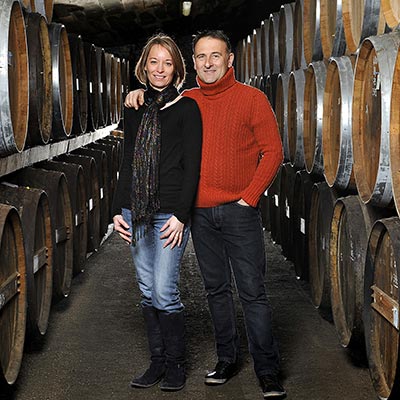Picture Gallery














































Distillation takes place in two stages. Only after the second distillation, called the "bonne chauffe", do we get the clear eau-de-vie which will become Cognac after a long ageing in oak casks.
Our vineyard is planted mostly with Ugni Blanc along with a little of Colombard, both of which are typical grape varietals for the Cognac region. The Ugni Blanc provides a high level of acidity that will help to naturally keep the wine until distillation./p>
This is the nerve racking period when in mid-September we harvest the fruit grown over the whole year. Once harvested, grapes selected to make Cognac are pressed directly. The juice is immediately left to ferment, while chaptalisation (addition of sugar) is strictly forbidden. The white wine is then transformed into eau-de-vie by distillation.
This is a fundamental step, when our lives are governed by the slow rhythm of the pot still, night and days alike, as distillation must be completed by 31 March following the vintage. Usually, distillation begins around mid-November. We distil the wine recently vinified from our harvest with its lees using two small traditional copper pot stills of only 10 hectolitres (1000L). This practice of using small stills favours maximum concentration of the aromas:
This is an essential step to transform an eau-de-vie into Cognac. It is carried out in French oak barrels of 250 to 400l. The eaux-de-vie age between 6months and 1 year in new barrels and get their color from the wood, slowly turning straw yellow. The Cognac is then transferred to older barrel for many years (up to 40 years for some of our Cognacs) where it gradually acquires a magnificent amber color and subtle flavours. During the ageing, the Cognac is regularly tasted by the estate's master blender to follow the development of the aromas.
All the time that the Cognac is in cask and sheltered by the cellars' thick walls, it is taking the best from the oak to develop its most exquisite flavours. As it is in permanent contact with the air, it will little by little lose some of its alcoholic strength and its volume. This natural evaporation is poetically known as "the Angels' share". These vapors feed a microscopic fungus called "torula compniacensis" that covers and blackens the stone walls of the cellars, giving them a mysterious and characteristic color.
When the time comes to bottle the Cognac, Patrick Drouet himself decides on the blending. He is the absolute Master and judge of what quantities of eaux-de-vie from different vintages should go into the blend of Drouet Cognac. Rigour, deep rooted passion and a quest for perfection during the blending process are behind our Cognacs’ undisputed reputation for quality. This has been recognised by the many medals and prizes that we have been awarded.
After the grape harvest and crush, we blend the natural grape-must with Cognac. This procedure, called "mutage", gives us Pineau des Charentes.
According to history, the creation of Pineau des Charentes was a happy accident : "In the 16th century, one day during the grape harvest, a winemaker poured some grape must into a barrel of Cognac eau-de-vie by accident. He was furious at his own clumsiness and put the useless barrel in a corner of his cellar. It was only a few years later, during an abundant grape harvest, that he went to fetch the barrel. Just as he was about to throw away the content, he was surprised to discover the marvellous clear liquid, full of sunshine just like the Charente region. Pineau des Charentes was thus born".
On the estate our grapes are picked by hand in order to select the healthiest bunches. White grape varietals Ugni Blanc and Colombard are used to make the white Pineau Blanc ; while red ones such as Merlot, Cabernet Franc and Cabernet Sauvignon are used for the pink Pineaux Rosés and the red Pineaux Rouges. After the harvest, Patrick Drouet blends the grapes in different proportions which are a closely guarded secret of alchemy.
The estate’s entire team takes the greatest care in the different stages of vinification: pressing, racking and "mutage" for the white pineaux blancs; de-stemming, maceration over various periods, "mutage" for the red pineaux rouges. "Mutage" of the grape-must with Cognac which is at least 60% ABV will eventually give an alcohol level of between 16 and 22% ABV. We have chosen to balance the sugar and the alcohol without using sulphur and that is why the alcohol volume of our Pineaux des Charentes is 18%. All these steps are minutely controlled as is the ageing in oak casks and they give our Pineaux des Charentes a consistent quality that is recognized by both professionals and Cognac lovers.